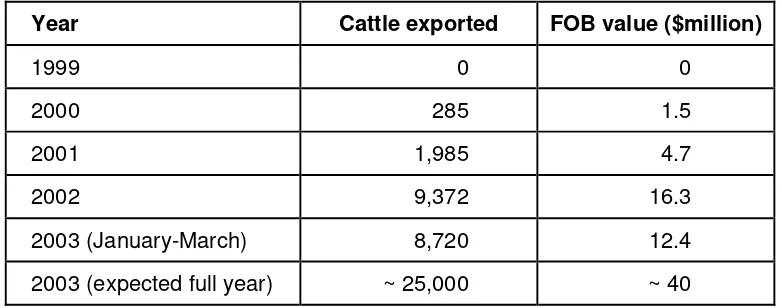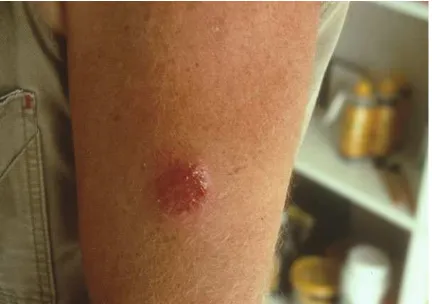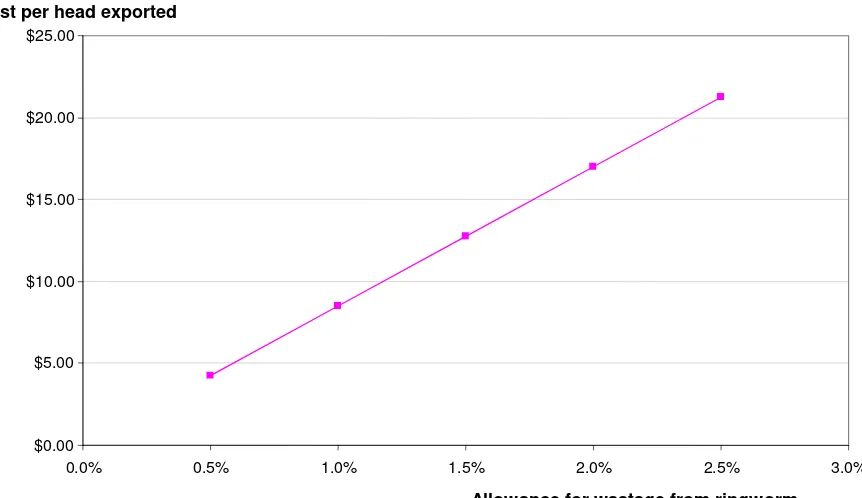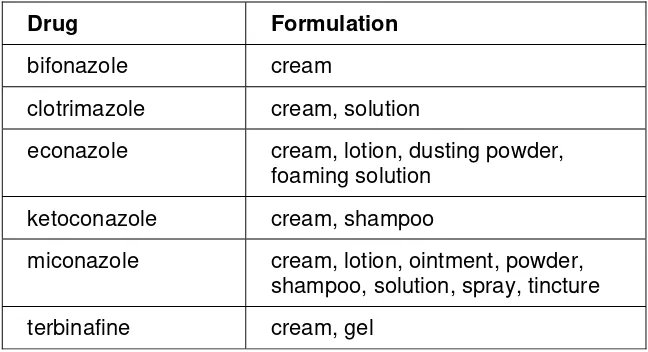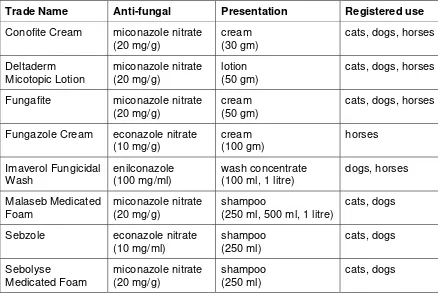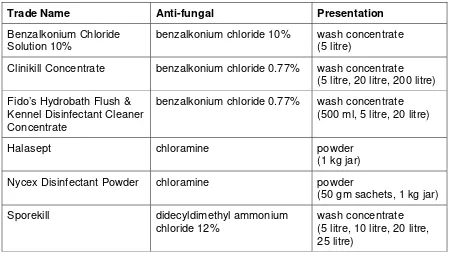export dairy cattle
Report prepared for MLA and Livecorp by:
Tony Brightling
Alwani Pty Ltd
PO Box 116
Parkville 3052
Ph: (03) 9347 3099
Email : [email protected]
Published by Meat & Livestock Australia Ltd ABN 39 081 678 364
May 2003
ISBN: 1 74036 193 8
MLA makes no representation as to the accuracy of any information or advice contained in this document and excludes all liability, whether in contract, tort (including negligence or breach of statutory duty) or otherwise as a result of reliance by any person on such information or advice. © Meat and Livestock Australia (2000)
2
Table of Contents
EXECUTIVE SUMMARY ...3
RECOMMENDATIONS ...4
INTRODUCTION ...5
THE DISEASE...6
Cause...6
Clinical signs ...7
Disease transmission...8
Human health...8
ECONOMIC COST ...9
TREATMENTS OF CHOICE ...11
Sensitivity to anti-fungal agents ...11
Treatment of affected cattle...12
Disinfectant of choice...14
VACCINATION ...15
Executive summary
There is strong demand for Australian dairy heifers in China. The Chinese export
protocol requires that cattle spend at least 30 days in pre-export quarantine, with multiple yardings required for disease testing and treatment. With susceptible young cattle from many different properties mixed together and lots of close physical contact, conditions during quarantine are ideal for ringworm spread. To date, all large shipments of cattle to China have had some cases of ringworm.
Ringworm is not life threatening – most cases heal by themselves, without treatment, in about eight weeks. However it causes significant economic loss to exporters. The
Chinese veterinarians sent to oversee export preparation are quite sensitive to ringworm. Cattle with severe or active lesions at the time of loading may be rejected from export. There is also a risk that ringworm developing at sea or after arrival in China will cause an incident that disrupts the market.
The primary aim of this project was to determine which fungi are most commonly involved and which treatments are likely to be most effective.
Skin scrapings were collected from ringworm affected cattle in six consignments exported to China during 2002. They were all identified as Trichophyton verrucosum. Imidazole compounds are the topical treatment of choice for cattle with ringworm. Iodine and chlorine based preparations have a much lower efficacy. Imaverol is the only registered imidazole product that can be readily applied to cattle as a spray. Treatment with an effective anti-fungal preparation will not induce a rapid clinical response. Regrowth of hair still takes some weeks. The most that can be expected is that established lesions develop no further, and that ringworm spread is contained. The products of choice for disinfecting cattle yards and handling facilities are cationic alkyl dimethylbenzyl ammonium halides. There are a number of preparations available, with choice based on availability and price.
There is a cattle ringworm vaccine registered for use in Europe and Canada, but not in Australia. The vaccine has registration claims for both treatment and prevention of ringworm in cattle. Two vaccinations, at least 14 days apart, are required to establish long-term immunity. The vaccine appears to be both safe and effective.
Vaccination provides the best hope of consistently achieving very effective ringworm control. Registration in Australia is needed before the vaccine can be used. With industry support, restricted registration for export use only might be possible, using registration data already available in Europe. This should be actively explored.
A fact sheet about ringworm in cattle is needed, written in both Mandarin and English, so that sound technical information is available to the Chinese veterinarians overseeing export preparation.
Exporters sending cattle to China should routinely adopt best practice ringworm control procedures.
Recommendations
Treatments of choice
1. Cattle with clinical ringworm are treated with an imidazole preparation. 2. A cationic alkyl dimethylbenzyl ammonium halide disinfectant is used to
disinfect cattle yards and handling facilities.
Vaccine registration
3. The live export industry actively explores with Boehringer-Ingelheim the cost and practicality of registering Insol ® Trichophyton vaccine for export use.
Ringworm fact sheet
4. A fact sheet on ringworm is prepared, written in English and Mandarin, with colour pictures of active and resolving lesions.
Best practice disease control
5. Exporters preparing cattle for export to China adopt a ringworm control program with the following key elements:
Not bringing cattle with active ringworm lesions into quarantine.
Keeping cattle that develop ringworm during quarantine isolated from other cattle that are not affected, and when cattle handling is required, putting ringworm affected cattle through the yards last.
Keeping the number of times that cattle are handled through the yards, and time in the yards, to a minimum.
Treating ringworm affected cattle each time they go through the yards, using an imidazole spray to minimise disease progression and the number of ringworm spores produced.
Disinfecting the forcing yards, race and cattle crush with a sporicidal disinfectant prior to quarantine receival, and again each time before cattle are handled through the yards.
Introduction
Over the last three years, the number of breeding cattle exported to China has increased rapidly. Most of the cattle exported to China have been Friesian dairy heifers, though there are also boutique markets for Jersey heifers and for beef cattle. The strong demand for Australian dairy heifers in China seems likely to continue for some years.
Table 1. The number and value of cattle exported to China.*
Year Cattle exported FOB value ($million)
1999 0 0
2000 285 1.5
2001 1,985 4.7
2002 9,372 16.3
2003 (January-March) 8,720 12.4 2003 (expected full year) ~ 25,000 ~ 40
* Source: Meat and Livestock Australia.
The Chinese export protocol requires that cattle spend at least 30 days in pre-export quarantine, during which time there are multiple yardings required for disease testing and treatment.
Ringworm can be a major problem for young cattle held in quarantine for any length of time in southern Australia. With susceptible young cattle from many different properties mixed together and lots of close physical contact, conditions during quarantine are ideal for ringworm spread. The disease is especially likely to affect cattle suffering nutritional, handling or other stress.
To date, all large consignments of dairy cattle exported to China have had some cases of ringworm develop during the pre-export quarantine period.
For cattle exported by sea, the disease also spreads on the ship. Close confinement and physical contact between cattle at sea and humid conditions in the stock house provide an ideal environment for ringworm spread.
Ringworm is not life threatening – most cases heal by themselves, without treatment, in about eight weeks. On-farm, in Australia, ringworm is simply allowed to run its course. However the disease causes significant economic loss to exporters preparing cattle for export to China. Extensive ringworm lesions look unsightly. The Chinese veterinarians sent to oversee the preparation of each shipment are very sensitive to ringworm - a disease which has no impact on productivity, but creates an obvious visual blemish and is a zoonotic disease.
Cattle that are severely affected or have active lesions at the time of loading may be rejected from export to China. Additional cattle must be sourced, tested and admitted to quarantine, at considerable cost, to allow for ringworm wastage during the quarantine period.
Ringworm occurs, but does not cause major economic loss, in cattle exported to destinations other than China. This is because of the shorter period of pre-export quarantine required and lower sensitivity to ringworm in other markets.
At the time this project was commissioned, it was common practice to spot treat ringworm lesions with an iodine or chlorine based spray. Mobs were sometimes sprayed with over-strength pool chlorine or sodium hypochloride. These treatments may have aided recovery and/or slowed down ringworm spread within the mob. However, they were empirical treatments, it was difficult to assess their efficacy, and treatment did not prevent significant economic loss from ringworm.
The primary aim of this project was to determine:
• which fungi are most commonly involved; and
• which treatments are likely to be most effective.
The disease
Cause
Reports from the scientific literature suggest that Trichophyton verrucosum is the principal cause of ringworm in cattle, though T mentagrophytes, T equinum,
Mycosporum gypseum, M nanum, M canis and other fungal organisms have been isolated from small numbers of ringworm affected cattle.
To confirm the causative organism(s) affecting cattle exported from southern Australia, skin scrapings were collected from a range of ringworm affected cattle in six different consignments being prepared for export to China during 2002:
• four consignments of Friesian dairy heifers;
• a consignment of Lowline cattle; and
• a consignment of Red Angus cattle.
The Friesian heifers were in quarantine at Portland. The Lowline and Red Angus cattle were in quarantine at two different sites on the outskirts of Melbourne.
The skin scrapings were sent to the Mycology Unit, Adelaide Women’s and Children’s Hospital for fungal culture, identification and sensitivity testing. The Mycology Unit at the Adelaide Women’s and Children’s Hospital is a microbiology laboratory with specialist expertise in human fungal infections.
Based on spore morphology, the samples were all identified as Trichophyton
verrucosum. It seems that Trichophyton verrucosum is the principal cause of ringworm in cattle exported live from southern Australia.
The fungus
Trichophyton verrucosum
is the principal cause of ringworm
in cattle exported live from southern Australia.
Clinical signs
Ringworm lesions on cattle are typically circular, up to about three centimetres in diameter, with hair loss and a grey crusty skin. Nearby lesions may coalesce to form larger patches. In the early stages the surface below the skin crust is moist, but later, during the healing phase, the skin is dry and the only signs are loss of hair and fine, flaky scales on the skin surface.
Ringworm occurs most commonly on the head and neck, though some affected cattle have a more generalised distribution, with ringworm patches over the entire body.
T. verrucosum feeds on keratin in the hair fibre and outer layer of the skin. It does not attack living tissue. Damage to the structure of the hair fibre causes it to break within the hair follicle, resulting in hair loss at the infection site. As a ringworm lesion
develops, the fungi causing the disease die out beneath the skin crust at the centre, but remain active at the periphery. This causes the centrifugal progression and
characteristic circular lesions.
Secondary bacterial infection or other complications are rare. Most affected cattle recover fully, without treatment, in about eight weeks.
Figure 1. Ringworm on the head and neck of a Friesian heifer.
Disease transmission
T. verrucosum exists in two separate forms:
• mycelia - which invade the skin, producing clinical signs of ringworm; and
• spores - which remain inert until germination, but are a source of environmental contamination and disease spread.
Spread from one beast to the next can occur with direct contact or indirectly with mycelia or spores deposited on inanimate objects such as yard railings, gateposts or the soil at stock camps; or inadvertently spread with human intervention during stock handling.
The fungal mycelia produce vast numbers of spores whilst multiplying in an active ringworm lesion. The spores are light and easily dispersed into the environment. Ringworm spores can exist on cattle skin without causing lesions, and such ‘carrier animals’ may be important sources of infection. Fungal spores can remain viable for years, provided they remain dry and cool. They germinate to become mycelia under warm, moist conditions, and if exposed to cattle skin can establish a new infection.
Human health
T. verrucosum principally affects cattle, but it can also cause ringworm in humans. Although the prevalence of ringworm in humans caused by T. verrucosum is very low, there is a strong association with exposure to dairy cattle.
T. verrucosum ringworm in humans typically occurs on exposed areas of skin on the scalp, face, neck or arms. Secondary bacterial infection is not uncommon. The disease is not life-threatening, but may cause irritation, discomfort and embarrassment.
In framing treatment and control recommendations, and in any discussions with
overseas trading partners, we must be mindful that ringworm is a zoonotic disease, and that people handling affected cattle are at risk.
Figure 2. Ringworm caused by T. verrucosum on a human arm.
Economic cost
There are two main areas of economic loss:
• the cost of treating ringworm affected cattle; and
• wastage, with cattle prepared for export in accordance with the Chinese protocol, but rejected prior to loading because of ringworm.
Treatment – Treatment of clinical cases during pre-export quarantine and at sea is a relatively minor cost. Depending on the prevalence of ringworm, the additional cost of drugs and labour for treatment could range from a few hundred to a couple of thousand dollars for a shipment with an FOB value of several million dollars. Treatment typically adds less than one dollar per head to export costs.
Rejection prior to loading – Rejection from export is the main cause of economic loss.
If the rejection of ringworm-affected cattle results in a consignment being loaded short, the cost to the exporter is the delivery price in China of the rejected cattle minus their salvage value in Australia.
If additional cattle are prepared for export to China, to allow for wastage from ringworm, the cost to the exporter is the cost of preparing the additional cattle (about $250 per head for all necessary tests, treatments and 30+ days in quarantine), plus the difference between the purchase price and salvage value of the additional animals. Using this more conservative estimate, and assuming an average purchase price of $1,200 per head and 50% salvage value for rejected animals, each additional animal prepared for export adds about $850 to export preparation costs. The cost is greater for animals with a higher quarantine entry price, such as pregnant heifers or bulls.
The prevalence of ringworm developing during pre-export quarantine varies from one consignment to another. During 2002, the proportion of cattle taken into quarantine for export to China, but rejected prior to loading because of ringworm, was typically in the range 0.5 – 2.5%.
Figure 3 shows the costs of ringworm per head exported as a function of the allowance for wastage from the disease, assuming each additional animal prepared for export adds $850 to export costs.
Rejection from export is the main cause of economic loss.
Figure 3. Cost of ringworm ($ per head exported)
xported
$25.
Cost per head e
00
$20.00
$15.00
$10.00
$5.00
$0.00
0.0% 0.5% 1.0% 1.5% 2.0% 2.5% 3.0%
Allowance for wastage from ringworm
Downstream rejection - Another potential cause of loss is the rejection and slaughter of ringworm affected cattle during post-arrival quarantine in China. The cost of any rejection after discharge is generally borne by the Chinese importer, and not by Australian interests. However, every loss in the delivery chain adds to total delivery costs, and reduces the competitiveness of Australian cattle.
Apart from the direct economic costs of the disease, there is also a risk that the delivery of ringworm affected cattle to China, or the development of ringworm during post-arrival quarantine, will cause an incident that seriously disrupts the market.
There is a risk that delivery of ringworm affected cattle or the
development of ringworm during post-arrival quarantine will cause an
incident that disrupts the market.
Treatments of choice
Sensitivity to anti-fungal agents
The fungal cultures in this study were consistently overgrown with saprophytic fungi – a common problem with fungal cultures. Culture media impregnated with cyclohexamide was used in an attempt to suppress saprophytic fungal growth, but the resulting cultures were not sufficiently pure for sensitivity testing.
No direct conclusions can therefore be made about the sensitivity to anti-fungal agents of the Trichophyton verrucosum samples in the study. However, humans also suffer from trichophytosis, and experience in human medicine provides a valuable guide to product efficacy.
Table 2 shows the treatments of choice currently recommended for trichophytosis in humans.
Table 2. Topical treatments of choice for trichophytosis in humans*
Drug Formulation
bifonazole cream
clotrimazole cream, solution econazole cream, lotion, dusting powder,
foaming solution
ketoconazole cream, shampoo miconazole cream, lotion, ointment, powder,
shampoo, solution, spray, tincture terbinafine cream, gel
* Source Therapeutic Guidelines: Dermatology (1999).
Five of the six anti-fungal agents recommended for topical treatment of trichophytosis in humans are synthetic imidazole group compounds. These are specific anti-fungal agents that work by inhibiting the biosynthesis of ergosterol, an essential compound in fungal cell membranes. Fungal resistance to the imidazoles does not seem to be a problem.
Terbinafine, the other recommended human treatment, is not currently registered or readily available for veterinary use.
Iodine and chlorine based preparations barely rate a mention in the medical literature as treatments for trichophytosis, because their efficacy is very much lower.
Imidazole group compounds are the topical treatment of choice in
human medicine. Iodine and chlorine based preparations have a much
lower efficacy.
Treatment of affected cattle
Topical treatment – Antifungal skin preparations that are registered for veterinary use in Australia and have an imidazole active are listed in Table 3. There are currently no products with an imidazole active registered for use on cattle.
Table 3. Antifungal skin preparations with an imidazole active registered for veterinary use in Australia
Trade Name Anti-fungal Presentation Registered use
Conofite Cream miconazole nitrate (20 mg/g)
cream (30 gm)
cats, dogs, horses
Deltaderm Micotopic Lotion miconazole nitrate (20 mg/g) lotion (50 gm)
cats, dogs, horses
Fungafite miconazole nitrate (20 mg/g)
cream (50 gm)
cats, dogs, horses
Fungazole Cream econazole nitrate (10 mg/g) cream (100 gm) horses Imaverol Fungicidal Wash enilconazole (100 mg/ml) wash concentrate (100 ml, 1 litre)
dogs, horses Malaseb Medicated Foam miconazole nitrate (20 mg/g) shampoo
(250 ml, 500 ml, 1 litre)
cats, dogs
Sebzole econazole nitrate (10 mg/ml) shampoo (250 ml) cats, dogs Sebolyse Medicated Foam miconazole nitrate (20 mg/g) shampoo (250 ml) cats, dogs
The cream, lotion and shampoo products listed in Table 3 are designed for application to individual animals or small groups. The package size and method of application are not well suited for treating large numbers of cattle, where spray application is needed. Imaverol Fungicidal Wash is the only product listed that can be readily applied as a spray. Imaverol is registered for use on cattle in Europe, but not in Australia, where treatment of cattle is an off-label use.
Imaverol is the only imidazole compound readily available in a form
that can be sprayed onto large numbers of cattle. It is the treatment of
choice.
Commonwealth legislation administered by the Australian Pesticides and Veterinary Medicines Authority allows the off-label use of pesticides on animals under veterinary care. In Victoria, where most of the cattle exported to China undergo pre-export
quarantine, State chemical use legislation also allows the off-label use of pesticides on animals under veterinary care. So although Imaverol is not registered for use on cattle, it may be legally used for this purpose if treatment is under the direction of the
exporter’s veterinarian.
Systemic treatment – There is no longer an oral ringworm preparation registered for treatment of Australian livestock. Griseofulvin has been used as an oral ringworm treatment for animals in the past, and is still used in human medicine. Oral preparations of the triazole compounds fluconazole, itraconazole and ketoconazole, and of
terbinafine, are also available as antifungal treatments for humans. However, it is most unlikely that an oral preparation would be the treatment of choice for ringworm in export cattle, based on cost, restricted availability and uncertain efficacy in cattle.
Sodium iodide is registered as an injectable treatment for ringworm in cattle. It is a time-honoured treatment, generally given by slow intravenous infusion, though it may be given subcutaneously. The mode of action of sodium iodide against fungal infections is unknown. Sodium iodide is moderately toxic, causing respiratory difficulty in some cattle after intravenous infusion and exfoliation of the skin at the injection site in some cattle treated subcutaneously. Treatment of pregnant cattle with sodium iodide is contraindicated, as abortion may occur as a side effect of treatment. Sodium iodide offers no obvious advantages over an effective topical treatment.
There are no oral or injectable treatments for ringworm in cattle that
provide any real advantage over topical treatment.
Response to treatment - Treatment with an effective anti-fungal preparation will not induce a rapid clinical response. Regrowth of hair still takes some weeks. The most that can be expected from an effective treatment is that established lesions will develop no further, and that spread elsewhere on the same animal and to other cattle will be contained.
The most that can be expected from an effective treatment is that
ringworm spread will be contained. Regrowth of hair still takes some
weeks.
Disinfectant of choice
Imaverol is too expensive to use as a disinfectant for cattle yards and handling facilities, and is less effective against fungal spores in the environment than against mycelia in an active ringworm lesion.
There are lots of disinfectants registered for agricultural or veterinary use in Australia. However, only a small number have a registered efficacy claim as a fungicide and are suitable for use as a large volume spray. They are listed in Table 4.
Table 4. Disinfectants with a registered efficacy claim as a fungicide and suitable for use as a large volume spray.
Trade Name Anti-fungal Presentation
Benzalkonium Chloride Solution 10%
benzalkonium chloride 10% wash concentrate (5 litre)
Clinikill Concentrate benzalkonium chloride 0.77% wash concentrate (5 litre, 20 litre, 200 litre) Fido’s Hydrobath Flush &
Kennel Disinfectant Cleaner Concentrate
benzalkonium chloride 0.77% wash concentrate (500 ml, 5 litre, 20 litre)
Halasept chloramine powder (1 kg jar)
Nycex Disinfectant Powder chloramine powder
(50 gm sachets, 1 kg jar) Sporekill didecyldimethyl ammonium
chloride 12%
wash concentrate (5 litre, 10 litre, 20 litre, 25 litre)
Note: Products containing centrimide and/or chlorhexidine have been excluded from the table. Although some disinfectants containing centrimide and/or chlorhexidine have antifungal claims registered, their mode of action is principally antibacterial, with low efficacy against fungal spores.
Information about the efficacy of the products listed in Table 4 at killing fungal spores is scant, so it is difficult to compare their suitability as ringworm disinfectants.
There are practical difficulties with chloramine. The powder is quite irritant, so care must be taken to avoid contact with the skin or eyes, and to avoid inhalation of chloramine dust.
Benzalkonium Chloride Solution, Clinikill Concentrate, Fido’s Hydrobath Flush & Kennel Disinfectant and Sporekill are all cationic alkyl dimethylbenzyl ammonium halides. As concentrates, they may irritate sensitive skin, but at wash strength they are very safe. Cationic alkyl dimethylbenzyl ammonium halides are also used as surgical and obstetrical disinfectants, udder washes and wound cleansing agents.
The choice between the cationic alkyl dimethylbenzyl ammonium halide disinfectants is essentially one of availability and price. They are all suitable for disinfecting cattle yards and handling facilities, and for blanket spraying ringworm affected cattle to minimise the spread of T. verrucosum spores.
Vaccination
There is a cattle ringworm vaccine (Insol ® Trichophyton) registered for use in Europe and Canada, but not in Australia. It is an inactivated vaccine which contains
microconidia to three strains of fungi:
• Trichophyton verrucosum (strain 410)
• Trichophyton mentagrophytes (strain 1032)
• Trichophyton sarkisovii (strain 551).
The vaccine has registration claims for both treatment and prevention of ringworm in cattle. Two vaccinations, given by intramuscular injection at least 14 days apart, are required to establish strong long-term immunity.
The vaccine appears to be both safe and effective. It has a three day meat withholding period, a nil withholding period for milk, and may be given to pregnant animals.
Ringworm vaccination of cattle was compulsory in Norway during the early 1980s, under a state-funded disease control program. Although no longer mandatory, it remains strongly recommended. Ringworm vaccination appears in the best practice dairy husbandry recommendations emanating from a number of veterinary schools and government institutes in both Europe and Canada.
Vaccination against ringworm, with an initial dose of vaccine given at the time of selection on-farm, and a second dose on entry to quarantine, might well reduce the prevalence of ringworm in cattle exported to China to a very low level. Immunity gained from vaccination in Australia would also provide protection against the disease after arrival in China.
There is a commercial market for the vaccine in Europe and Canada, where cattle are kept in barns for extended periods each year with close animal-to-animal and human contact. However, there is not a commercial market for the vaccine in Australia, where cattle are kept outdoors year-round, and if ringworm occurs, the disease is simply allowed to run its course.
It is very costly to bring a vaccine for use in food producing animals onto the open market in Australia, with an array of efficacy, safety, residue and other data required for registration. In the absence of a broad commercial market or an industry sponsor, there is no prospect of the Insol ® Trichophyton vaccine becoming fully registered in
Australia. However, it may be possible to obtain restricted registration (eg. for use under permit, for export purposes only), based largely on data already available in Europe.
If the Insol ® Trichophyton vaccine were available in Australia, it would provide a new and possibly very effective way of controlling ringworm in cattle exported to sensitive markets.
The live export industry should explore with Boehringer-Ingelheim (the European registrants) the costs and practicality of obtaining Australian registration of Insol ® Trichophyton vaccine, for export purposes. Some industry funding support may be needed.
Insol ® Trichophyton vaccine would be a new way of controlling
ringworm. Given current Chinese protocol requirements, vaccination
provides the best hope of consistently achieving very effective
ringworm control.
Industry risk management
From an industry perspective, four separate strategies are needed to minimise the cost of ringworm and the threat that it poses to the China export trade:
• desensitise the Chinese veterinary authorities to ringworm;
• seek a reduction in the pre-export quarantine period for cattle exported to China;
• encourage ringworm vaccine registration in Australia; and
• promote best practice management of the disease by Australian exporters.
Chinese sensitivity to ringworm – Ringworm is an OIE list C disease that occurs worldwide. Whilst it would be better not to have ringworm affected animals in the export system, its significance needs to be placed in perspective. Ringworm is a transient disease that disappears without treatment and has no noticeable effect on productivity. A simple fact sheet on ringworm is needed, written in English and Mandarin, with colour pictures of active and resolving lesions. The buyer is always right and we must respect decisions made by the Chinese veterinarians supervising each shipment. However, it would be helpful if some factual information about ringworm were readily available to assist such decision-making.
A fact sheet on ringworm is needed, written in English and Mandarin,
with colour pictures of active and resolving lesions.
Reduce time in quarantine– Ringworm is a particular problem for the live cattle export trade to China because of the extended period of pre-export quarantine and multiple yardings required to comply with the Chinese export protocol. If time in quarantine were reduced, the cost of export preparation and prevalence of ringworm (and pinkeye, lameness and other diseases) would also be reduced.
From a risk mitigation perspective, thirty plus days in quarantine provides China with no greater assurance of disease freedom than seven or fourteen days – if anything, the disease risk increases the longer that cattle are held in pre-export quarantine. The difficulties negotiating a shorter, simpler, less expensive export protocol with the Chinese veterinary authorities are recognised. However, this should remain a long-term industry objective.
Negotiating a shorter, simpler export protocol to China should remain a
long-term industry objective.
Ringworm vaccine registration – Encouraging the Australian registration of a cattle ringworm vaccine is important because vaccination has the potential to prevent
ringworm spread at all stages of the export chain. Given current protocol requirements, vaccination provides the best hope of consistently achieving very effective disease control.
Best practice disease control – Based on current knowledge, best practice ringworm control for large consignments of susceptible young cattle held in pre-export quarantine for an extended period would seem to involve:
• Not bringing cattle with active ringworm lesions into quarantine.
• Keeping cattle that develop ringworm during quarantine isolated from other cattle that are not affected, and when cattle handling is required, putting ringworm affected cattle through the yards last.
• Keeping the number of times that cattle are handled through the yards, and time in the yards, to a minimum.
• Treating ringworm affected cattle each time they go through the yards, using an imidazole spray to minimise disease progression and the number of ringworm spores produced.
• Disinfecting the forcing yards, race and cattle crush with a sporicidal disinfectant prior to quarantine receival, and again each time before cattle are handled through the yards.
Exporters sending cattle to China should routinely adopt best practice
ringworm control procedures.
